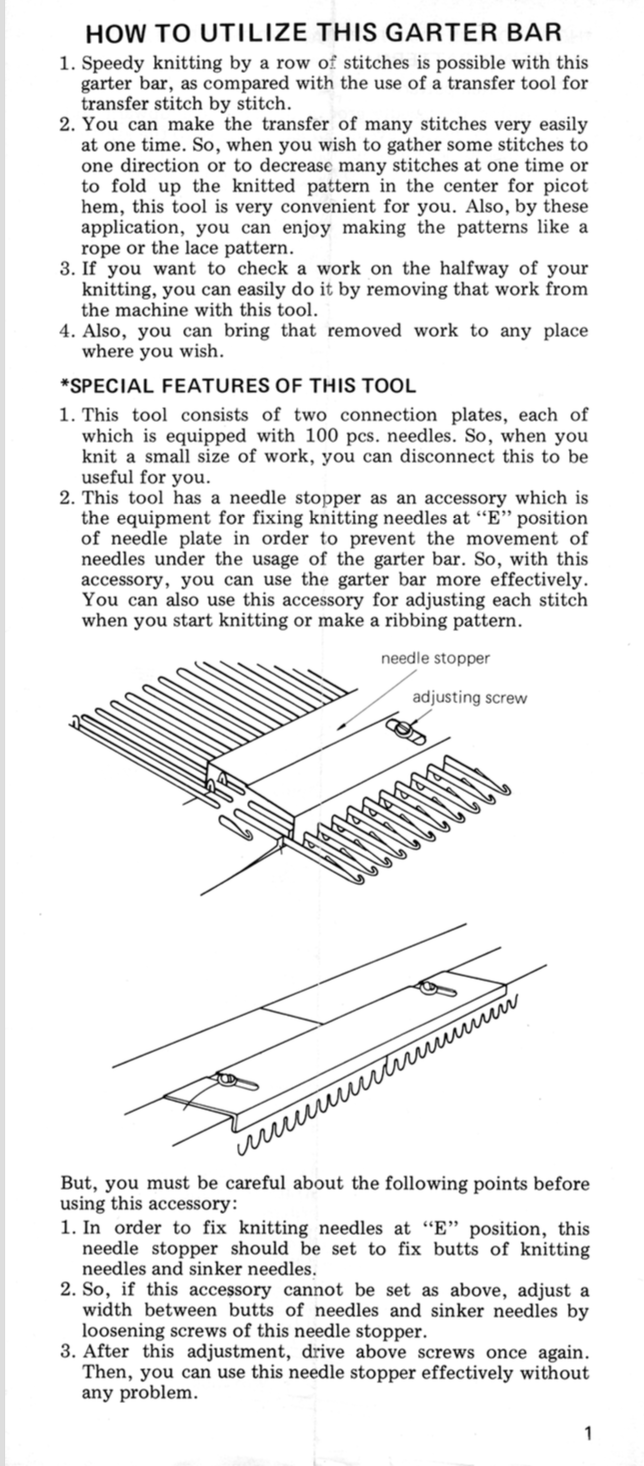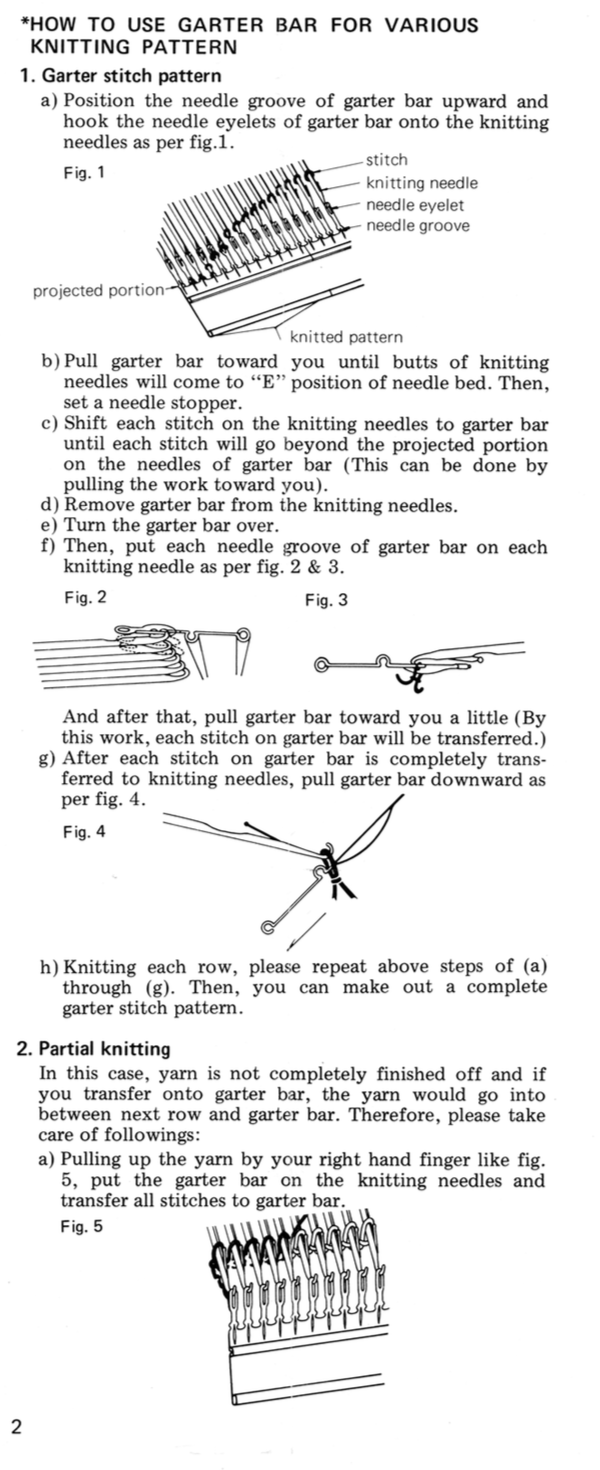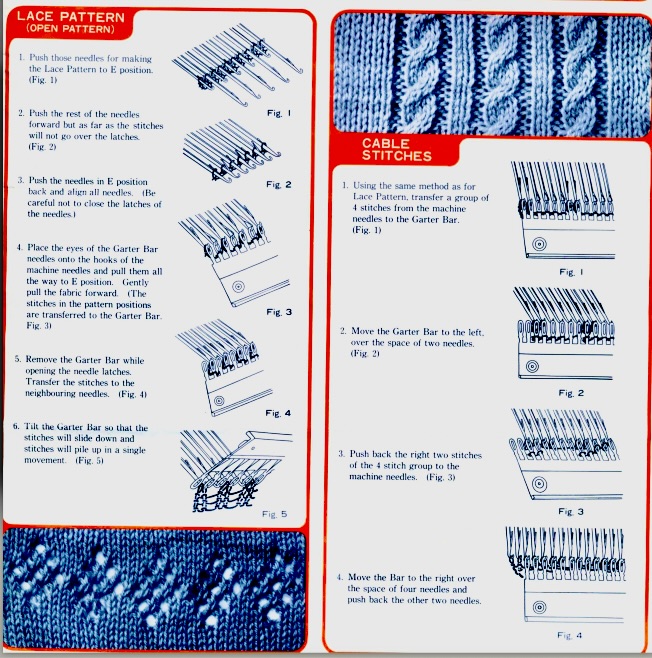This technique can be used in many ways including to attach a front band to a sweater, body pieces of a garment such as when knitting a raglan sleeve from the top-down, flat pieces of knitting to make a tube ie in some socks, and for decorative joins adding a strip of knitting between 2 (or more) previously completed pieces. Most often, one is joining the 2 (or 3) pieces with the purl side facing.
Looking at the purl side of any knitting you will see a knot and a loop along the side edges of the work. The loop is formed on the carriage side at the start of each pass, the “knot” opposite the starting carriage side as that side of that row is reached and the yarn twists. 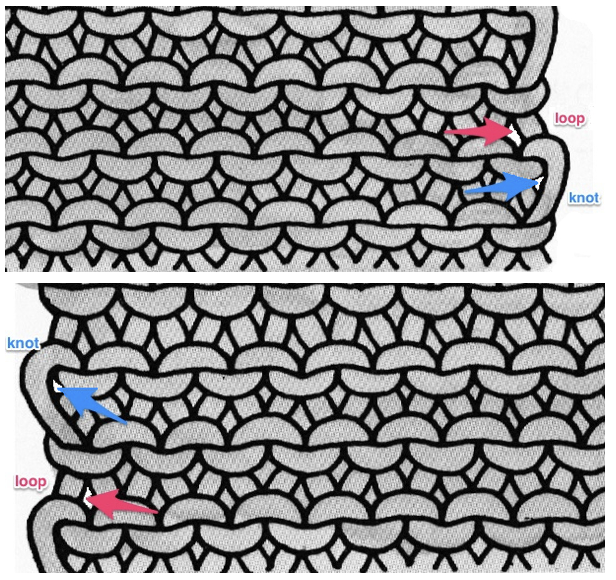 Work the first piece, A, and remove it from the machine. Generally, with a smaller row gauge it is best to join loops, with thicker yarns, and larger stitches, or if you plan to felt the finished piece, work with the knots. Any single or even double-eye tool, Jolie, or another favorite may be used to insert into the individual space at the edge for picking up.
Work the first piece, A, and remove it from the machine. Generally, with a smaller row gauge it is best to join loops, with thicker yarns, and larger stitches, or if you plan to felt the finished piece, work with the knots. Any single or even double-eye tool, Jolie, or another favorite may be used to insert into the individual space at the edge for picking up.
If joining rows to rows: begin the second piece, B. Though the join can happen on either side, in this case, cast on, knit a row, and end with the carriage on the right side (COR). Pick up the first knot (or loop) on A, from its bottom-up, and hang it onto the left end needle (opposite the carriage) of the cast on row for B.
Knit two rows, returning to COR
Go to the next knot (loop) on A. Pick it up and place it on the outside left edge needle of B, opposite the carriage.
Knit 2 rows and continue on, repeating the last 2 steps to the desired length.
Remember to pick up knots (loop) opposite the carriage every other row.
If the pieces to be joined are long, place a yarn marker on the side(s) to be joined at regular intervals simply by adding a short piece of contrasting color yarn and laying it in the hook on the end needle(s). It will not become a permanent part of the stitch. The markers will serve as guides in seaming, and can be easily removed when they are reached by a quick tug.
 Open stitches may also be joined using this method, but they would have to be hooked onto the second piece every row rather than every other, and caution should be taken in terms of skipping any stitch, as any such stitch will unravel at the end of the process unless it has been secured.
Open stitches may also be joined using this method, but they would have to be hooked onto the second piece every row rather than every other, and caution should be taken in terms of skipping any stitch, as any such stitch will unravel at the end of the process unless it has been secured.
If a bound-off edge of a sideways knit is joined to a knit band, then some adjustment in gauge or row count needs to be made. Knit stitches generally around 4 in width to 3 in height so every 4th part of the bound-off chain may need to be skipped  Depending on the stitch type and yarn used a simple tension change and observing the loop (knot) rule every other row may work without any additional adjustments. The Brother Knitting Technique Book offers an interesting variation as a way of creating a double-wide repeat using a punchcard motif
Depending on the stitch type and yarn used a simple tension change and observing the loop (knot) rule every other row may work without any additional adjustments. The Brother Knitting Technique Book offers an interesting variation as a way of creating a double-wide repeat using a punchcard motif 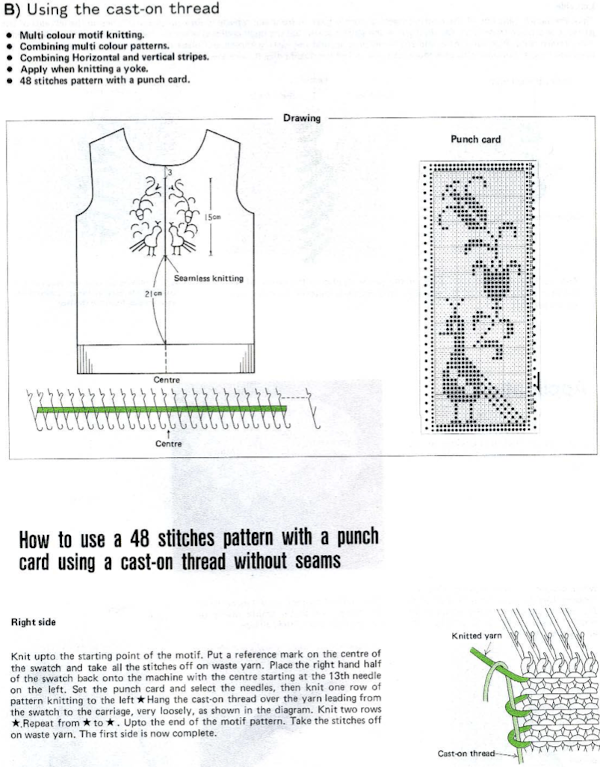
 This is a long-ago demo swatch. The chevrons are shaped by holding, could be knit on any machine in any width. After the first strip is knit to the desired length, the second is joined to it as it is being knit. I generally prefer the joins with the carriage on the right and the completed strip hooked onto its left side. If the color changer is to be used, then the strip being created to join to the finished piece should always be knit on the left side of the bed in order to allow for traveling to and from the color changer every 2 rows. The image here is turned sideways, the chevrons could be used either vertically or horizontally depending on the design plans.
This is a long-ago demo swatch. The chevrons are shaped by holding, could be knit on any machine in any width. After the first strip is knit to the desired length, the second is joined to it as it is being knit. I generally prefer the joins with the carriage on the right and the completed strip hooked onto its left side. If the color changer is to be used, then the strip being created to join to the finished piece should always be knit on the left side of the bed in order to allow for traveling to and from the color changer every 2 rows. The image here is turned sideways, the chevrons could be used either vertically or horizontally depending on the design plans. 
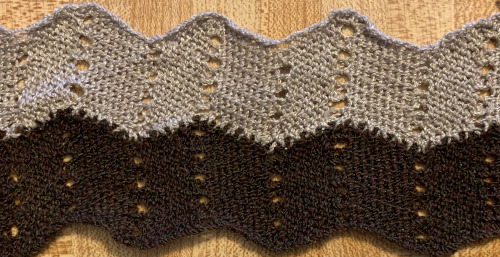 The above method may be used to join fair isle patterns in order to achieve significantly wider final panels. Some artists, when no electronic models were available, would join cards in continued lengths and plan their repeats side by side to achieve large, non-repetitive images. The punchcard width markings on your Brother needle tape can serve as guides. I use punchcard repeats so often I replaced the needle tape in my 910 early on with one for punchcard models. Markings may also be seen on them for every 8 stitches
The above method may be used to join fair isle patterns in order to achieve significantly wider final panels. Some artists, when no electronic models were available, would join cards in continued lengths and plan their repeats side by side to achieve large, non-repetitive images. The punchcard width markings on your Brother needle tape can serve as guides. I use punchcard repeats so often I replaced the needle tape in my 910 early on with one for punchcard models. Markings may also be seen on them for every 8 stitches  If the second piece is to be joined with the new piece on its right, add a single stitch to the full punchcard repeat (solid line or thin line section on tape, anywhere on the bed) on the right side, hook up the edge loop (or knot) from the first piece onto the new one, which uses the same needle location as that extra needle in the previous piece for the first stitch in work on its left (full line or blank space on tape). The cast on thread as shown in the techniques publication is not necessary. If wishing to join on the opposite side, then add the extra needle to the first piece on the left edge of the full repeat. With care one can plan for smaller stitch repeats as well. The needle tape or even the knit bed may be marked with water-soluble markers to indicate the extra needle position when adding new vertical strips of knitting. In this former demo swatch, I used a space-dyed yarn for the ground accounting for the difference in color on each piece. Color pooling in such yarns is another consideration that may require specific planning in any technique.
If the second piece is to be joined with the new piece on its right, add a single stitch to the full punchcard repeat (solid line or thin line section on tape, anywhere on the bed) on the right side, hook up the edge loop (or knot) from the first piece onto the new one, which uses the same needle location as that extra needle in the previous piece for the first stitch in work on its left (full line or blank space on tape). The cast on thread as shown in the techniques publication is not necessary. If wishing to join on the opposite side, then add the extra needle to the first piece on the left edge of the full repeat. With care one can plan for smaller stitch repeats as well. The needle tape or even the knit bed may be marked with water-soluble markers to indicate the extra needle position when adding new vertical strips of knitting. In this former demo swatch, I used a space-dyed yarn for the ground accounting for the difference in color on each piece. Color pooling in such yarns is another consideration that may require specific planning in any technique. 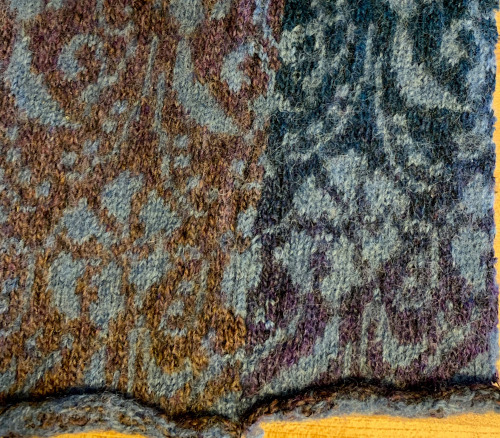
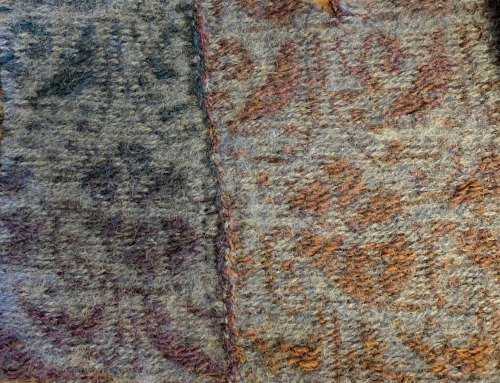 Here a slip-stitch ruffle was joined on the left to one of my completed shawl bodies.
Here a slip-stitch ruffle was joined on the left to one of my completed shawl bodies.  The above discussion is based on joins occurring on the same needle location on the needle bed. There is no reason why that should be a constant. A strip or shape can be created with two separate, completed knit pieces joined to it as it progresses in length. “Always” hook onto the new piece opposite the carriage, with usually a minimum of 3 stitches on the new center panel.
The above discussion is based on joins occurring on the same needle location on the needle bed. There is no reason why that should be a constant. A strip or shape can be created with two separate, completed knit pieces joined to it as it progresses in length. “Always” hook onto the new piece opposite the carriage, with usually a minimum of 3 stitches on the new center panel.
Here I grabbed 2 random swatches, one is knit side out, the other purl side out, and one is upside down. The magenta yarn is thinner than the wool, the tension initially used was a dot more than one, left that way by some other experiment or poltergeists. It pays to check all settings prior to beginning any project. To start with I cast on with the magenta and knit a row, hooked up the loop from piece one, starting from its planned bottom edge, COL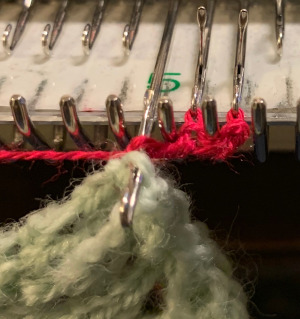 knit one row to the other side, hooked up piece 2, COR
knit one row to the other side, hooked up piece 2, COR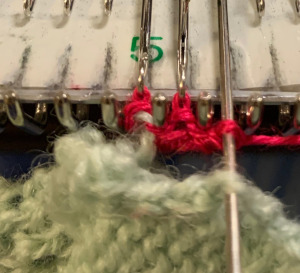 and continued until I reached the point where I wanted to experiment with increases, keeping the shape symmetrical. I picked up a loop from both added pieces and hooked them onto the first empty needle on each side of the strip, essentially casting on an added stitch on each side each time, following with 2 knit rows.
and continued until I reached the point where I wanted to experiment with increases, keeping the shape symmetrical. I picked up a loop from both added pieces and hooked them onto the first empty needle on each side of the strip, essentially casting on an added stitch on each side each time, following with 2 knit rows. 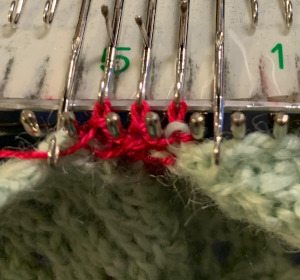 After working on my “desired shape” I tested decreases:
After working on my “desired shape” I tested decreases: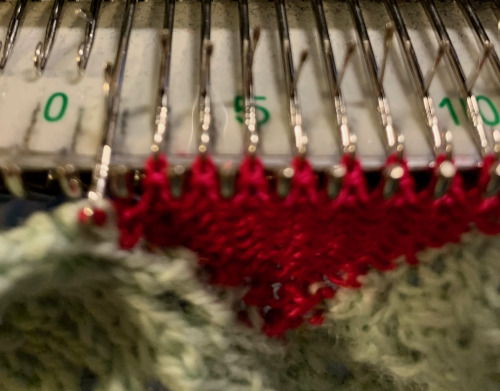 COR: after hooking up the next row, knit one row to the left
COR: after hooking up the next row, knit one row to the left  and transfer the stitch just created on the left onto the adjacent needle on its right, creating a simple decrease. Knit to the right and continue with a straight edge on the right side, repeating the decrease on the left every other row,
and transfer the stitch just created on the left onto the adjacent needle on its right, creating a simple decrease. Knit to the right and continue with a straight edge on the right side, repeating the decrease on the left every other row,  I kept a straight edge on the right after I reached the top of the piece there. Here is the reverse side of the piece.
I kept a straight edge on the right after I reached the top of the piece there. Here is the reverse side of the piece.  The cleanest joins happen when the edges are straight to start with, above there was a movement of the edges happening because of the distortion of the fabric created by the eyelets. A light pressing if possible may also set the edge stitches, help them lie flat, and make them more visible. When working with slanted edges on the first piece this is one way to join it, taking into consideration whether any adjustment in the frequency of hooking up needs to be made.
The cleanest joins happen when the edges are straight to start with, above there was a movement of the edges happening because of the distortion of the fabric created by the eyelets. A light pressing if possible may also set the edge stitches, help them lie flat, and make them more visible. When working with slanted edges on the first piece this is one way to join it, taking into consideration whether any adjustment in the frequency of hooking up needs to be made. 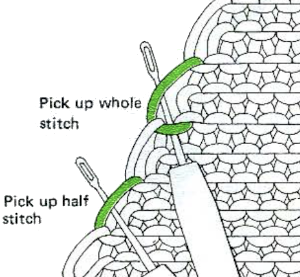 A better edge will be obtained if the decreases to that piece were made using the full-fashioned method, resulting in a neat “chain” for pick up along its finished edge.
A better edge will be obtained if the decreases to that piece were made using the full-fashioned method, resulting in a neat “chain” for pick up along its finished edge.
Joining lace motifs  There are other options for decorative joins as one knits, one such is shown in a video by Roberta Rose Kelly.
There are other options for decorative joins as one knits, one such is shown in a video by Roberta Rose Kelly.
And not to be forgotten, playing with materials or anything else that allows for an edge to be hooked onto a latch holding a knit stitch ;-). Here the add-on is polar fleece, it could be crochet, lace, etc.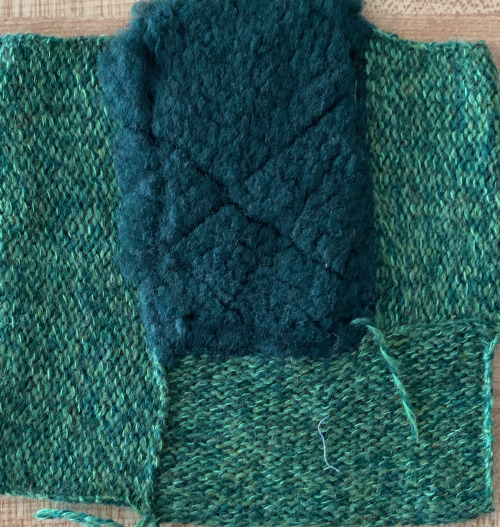
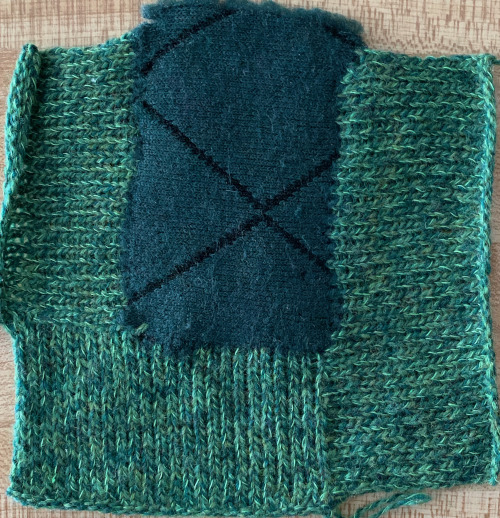
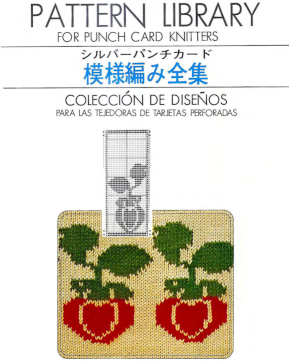

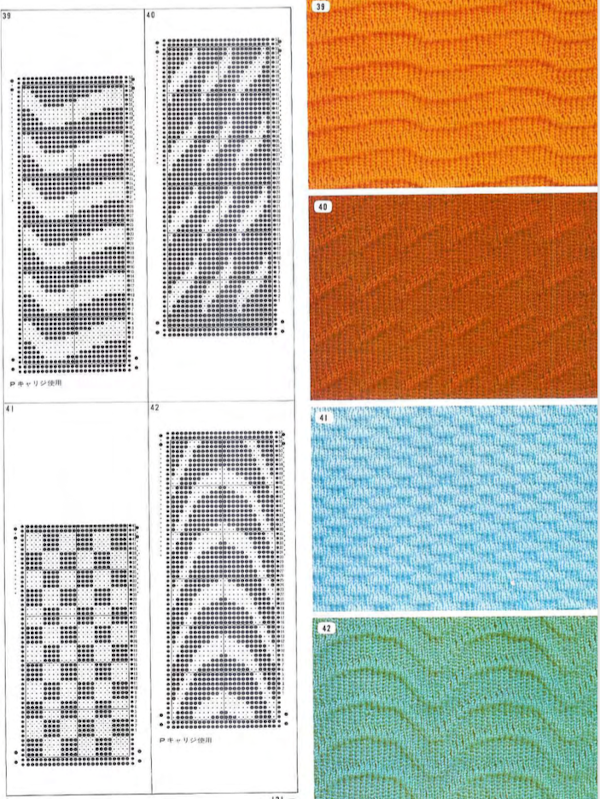
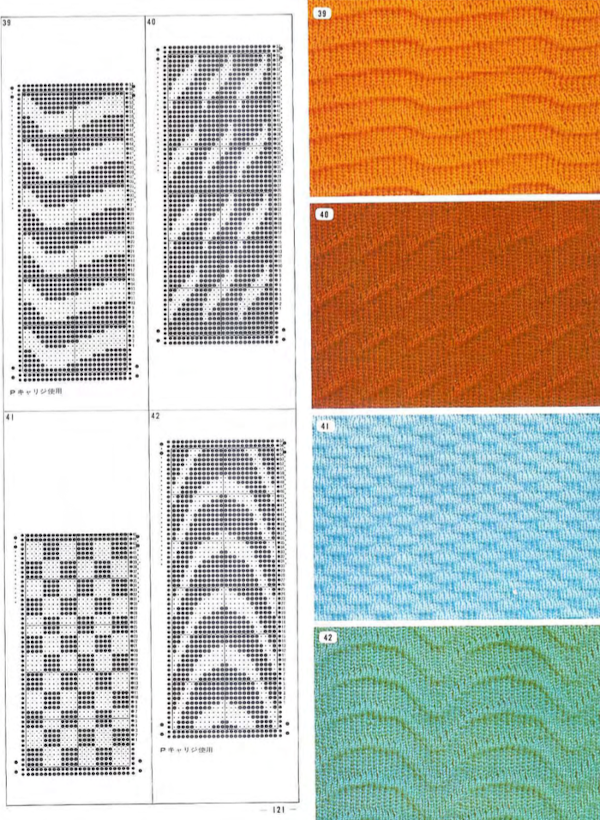
 from the Brother Ribber techniques book
from the Brother Ribber techniques book 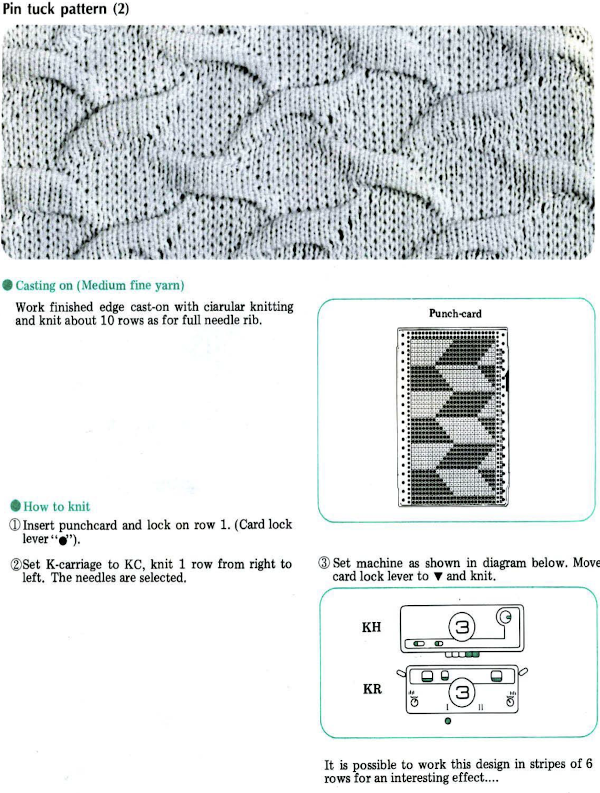


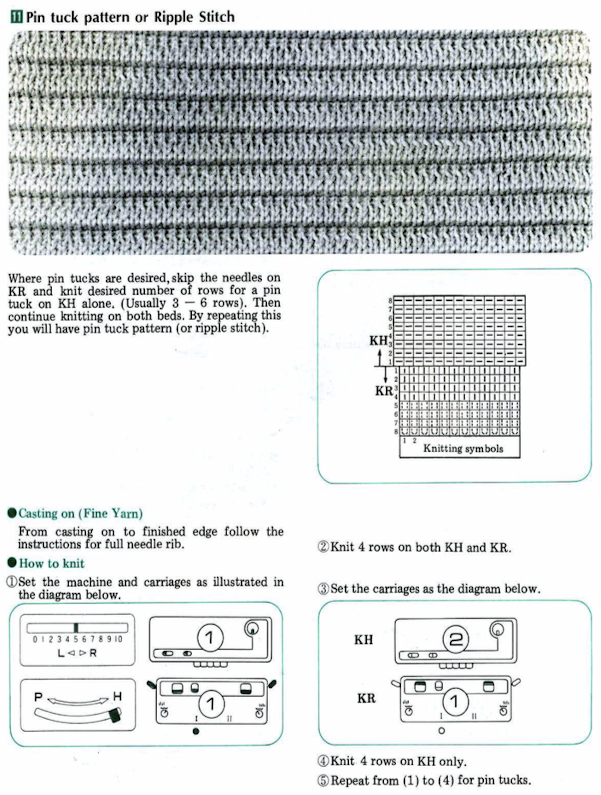



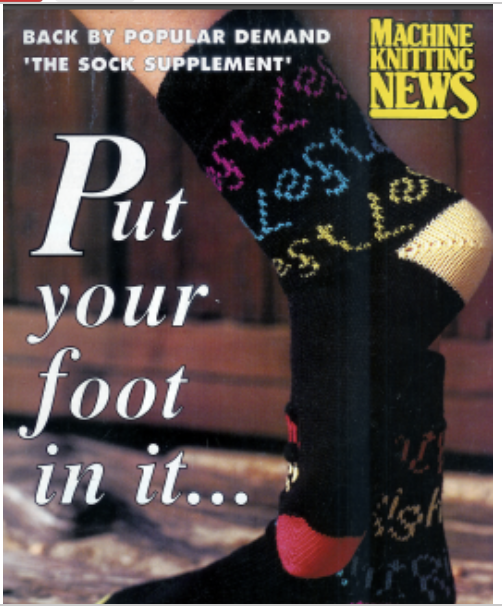

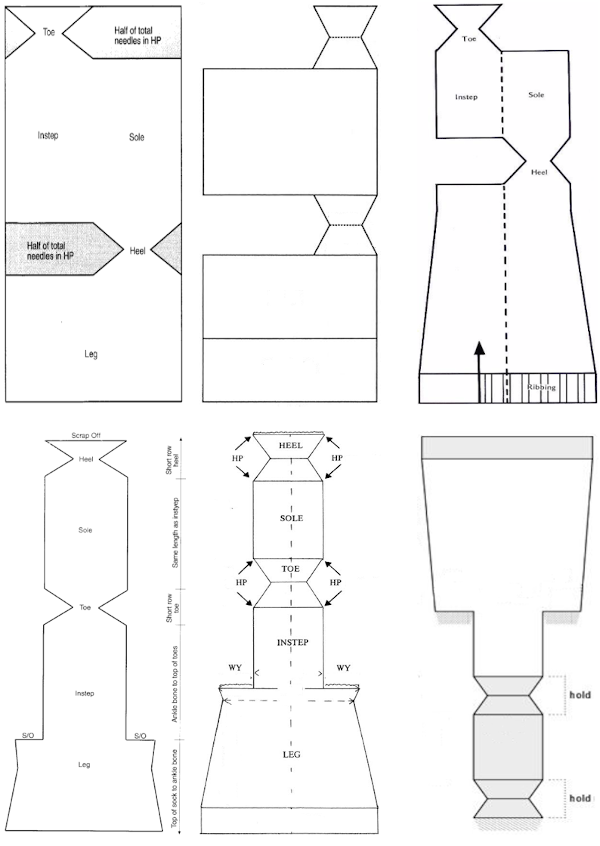 Patterns from manufacturers: Superba manual
Patterns from manufacturers: Superba manual 


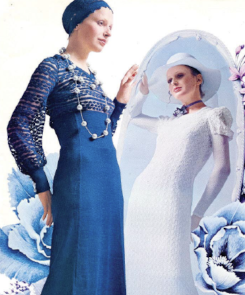
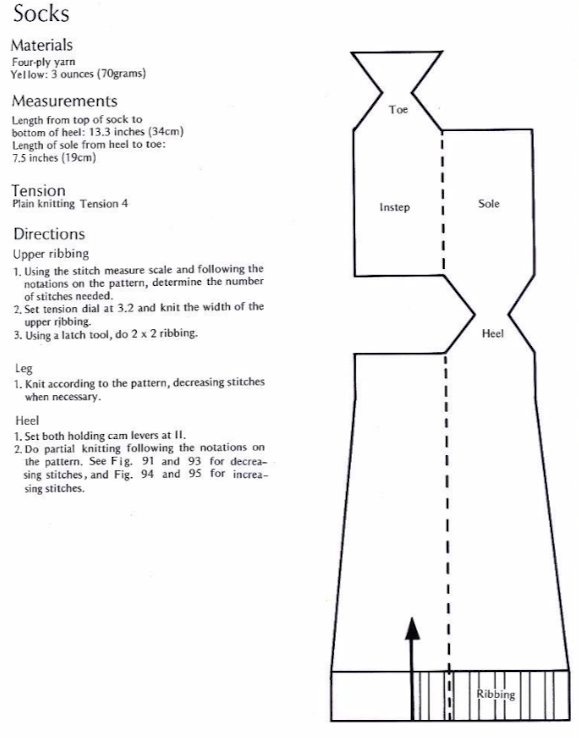
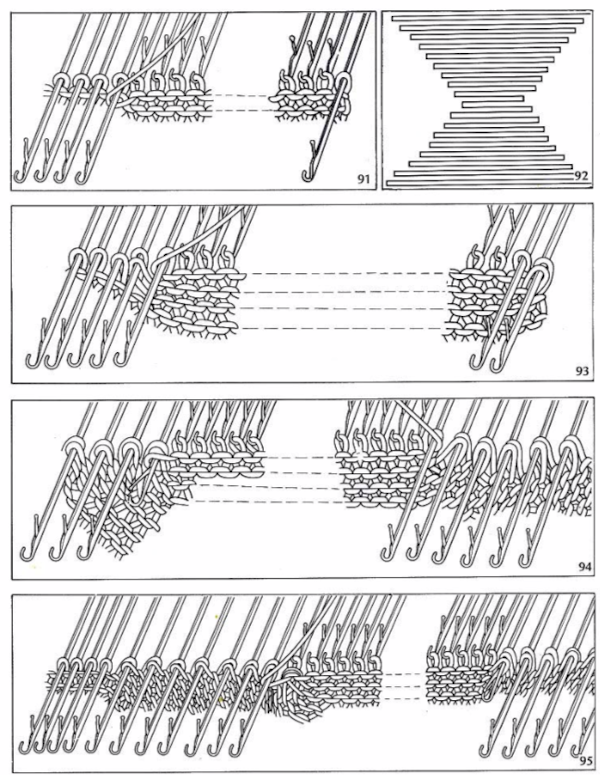



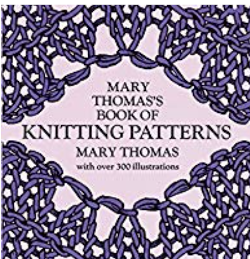 on page 38 a repeat and instructions are offered for a spiral tube sock. The latter has no heel shaping, but traditional toe shaping can be added.
on page 38 a repeat and instructions are offered for a spiral tube sock. The latter has no heel shaping, but traditional toe shaping can be added. 


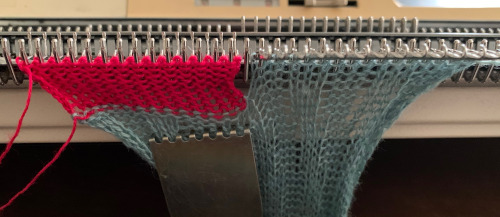



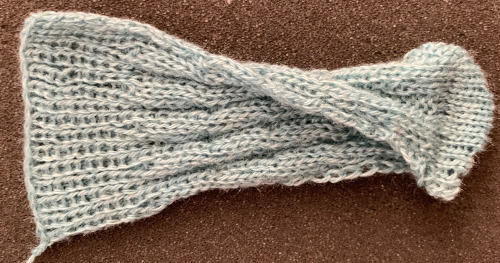

 Lastly, it is possible to knit socks sideways (as well as gloves), usually in garter stitch and in hand knitting. This is a crochet illustration that points to the general construction method.
Lastly, it is possible to knit socks sideways (as well as gloves), usually in garter stitch and in hand knitting. This is a crochet illustration that points to the general construction method.

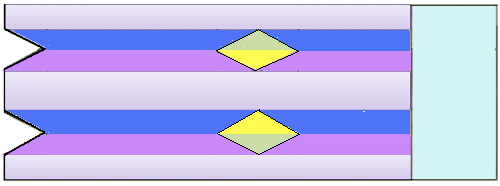
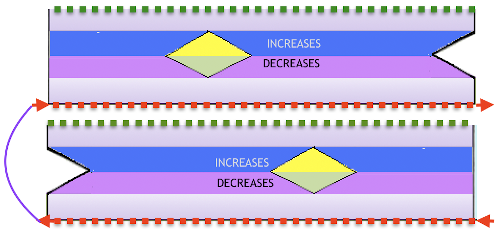
 I asked on Ravelry for advice or shared experiences. A possible culprit was suggested to me, and I was pointed toward the
I asked on Ravelry for advice or shared experiences. A possible culprit was suggested to me, and I was pointed toward the When I tried to turn the screws marked in red I found they were loose. After I took apart the racking handle, braving far more disassembly than turned out to be needed, housing little screws and washers in separate small plastic containers along with their comrade larger parts, I found perhaps I could have reduced the effort considerably. I did not take photos during the process, as I was not brimming with confidence in the result. Enlarging a portion of the above helped me understand how parts related to each other a bit better.
When I tried to turn the screws marked in red I found they were loose. After I took apart the racking handle, braving far more disassembly than turned out to be needed, housing little screws and washers in separate small plastic containers along with their comrade larger parts, I found perhaps I could have reduced the effort considerably. I did not take photos during the process, as I was not brimming with confidence in the result. Enlarging a portion of the above helped me understand how parts related to each other a bit better. 
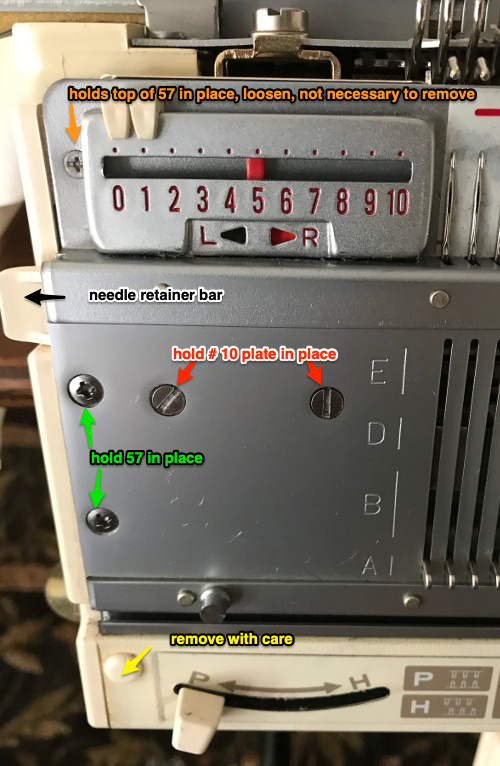
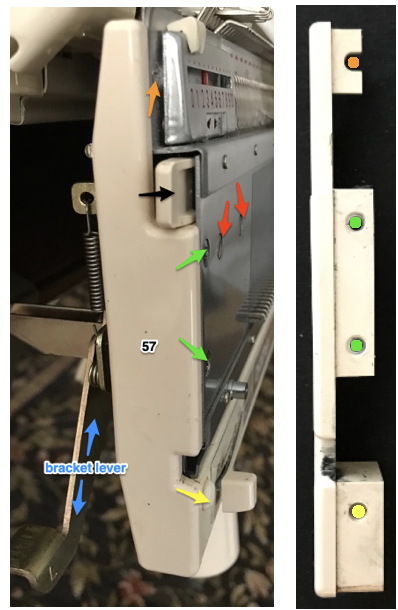
 It really may not have been necessary to even remove the bracket lever. The #10 piece of metal was loose inside the machine, might simply have fallen out if I had turned the bed on its side and given it a mild shake after removing #57. This is with the piece in question in its housing where it belongs (white arrow), shown in relation to the needle retainer bar (black arrow) and screws marked with red arrows that hold it in place.
It really may not have been necessary to even remove the bracket lever. The #10 piece of metal was loose inside the machine, might simply have fallen out if I had turned the bed on its side and given it a mild shake after removing #57. This is with the piece in question in its housing where it belongs (white arrow), shown in relation to the needle retainer bar (black arrow) and screws marked with red arrows that hold it in place.  The piece is obviously thinner than the space it lives in, so for screws to anchor it properly, a flathead screwdriver or other improvised tool needs to be inserted under it, lifting it into position and holding it in place with its holes lined up with outside of bed so screws can grip it and be tightened properly.
The piece is obviously thinner than the space it lives in, so for screws to anchor it properly, a flathead screwdriver or other improvised tool needs to be inserted under it, lifting it into position and holding it in place with its holes lined up with outside of bed so screws can grip it and be tightened properly. 
 a rearview with ends woven in
a rearview with ends woven in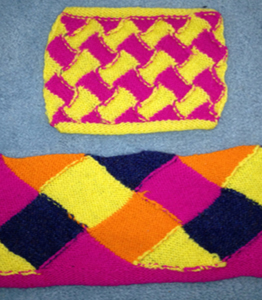

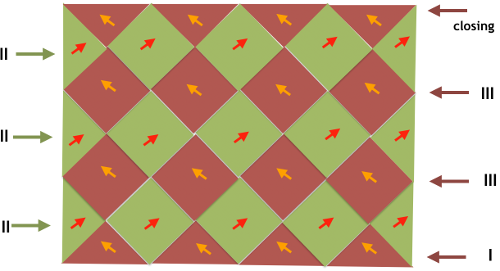
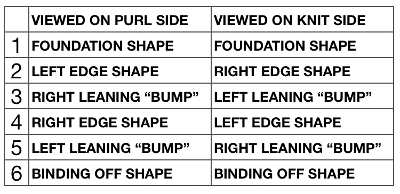

 When the end of the first row that row is reached, as contrast color is added, stitches need to be cast on on the far left in order to keep the work on the bed a constant number of stitches. The usual method suggested is e wrapping, this is picking up from the row below. I found either method produced looser, longer stitches on the far edge
When the end of the first row that row is reached, as contrast color is added, stitches need to be cast on on the far left in order to keep the work on the bed a constant number of stitches. The usual method suggested is e wrapping, this is picking up from the row below. I found either method produced looser, longer stitches on the far edge 
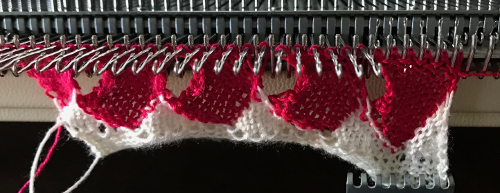 reaching the far right:
reaching the far right: 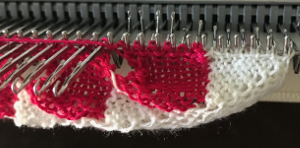

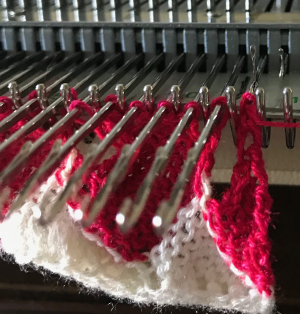
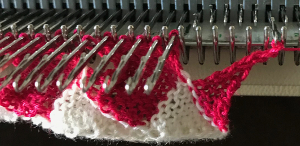

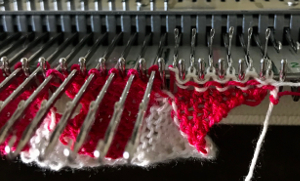
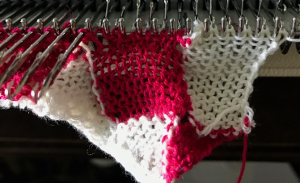

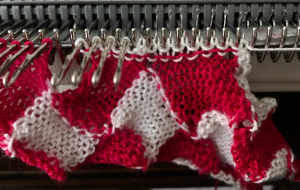
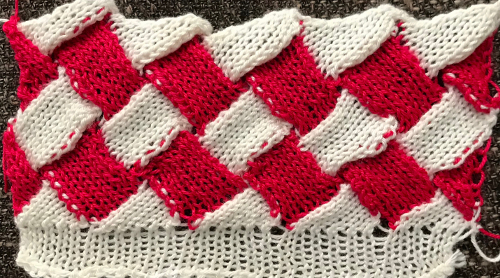
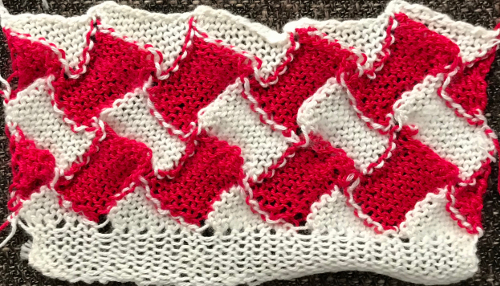
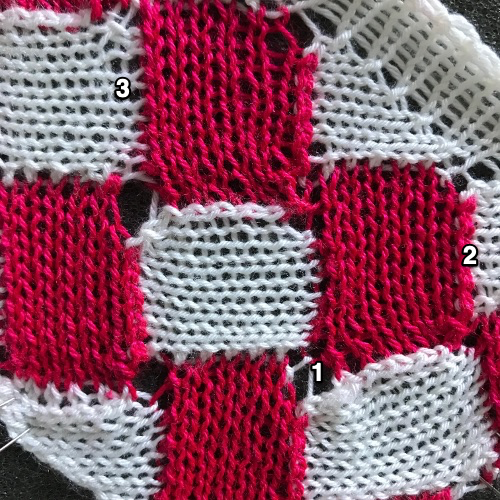
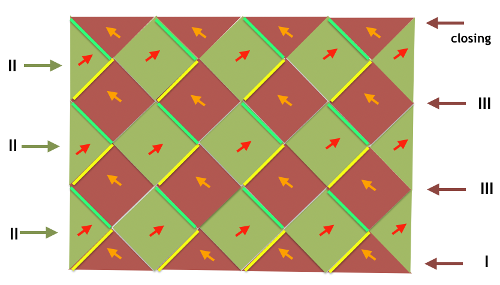
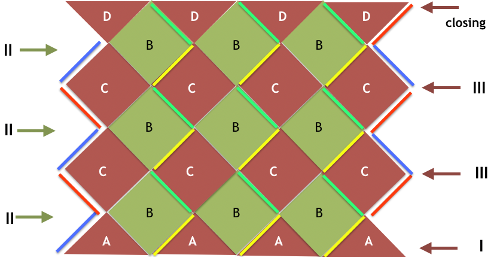

 It does a good job of weighing down those straight edges along the bumps, making the stitches easier to pick up. When rehanging those stitches, uniformly hanging the loops, not the knots along the edges involved will give a smoother join. Here a paper clip is used as the “hanger”
It does a good job of weighing down those straight edges along the bumps, making the stitches easier to pick up. When rehanging those stitches, uniformly hanging the loops, not the knots along the edges involved will give a smoother join. Here a paper clip is used as the “hanger”
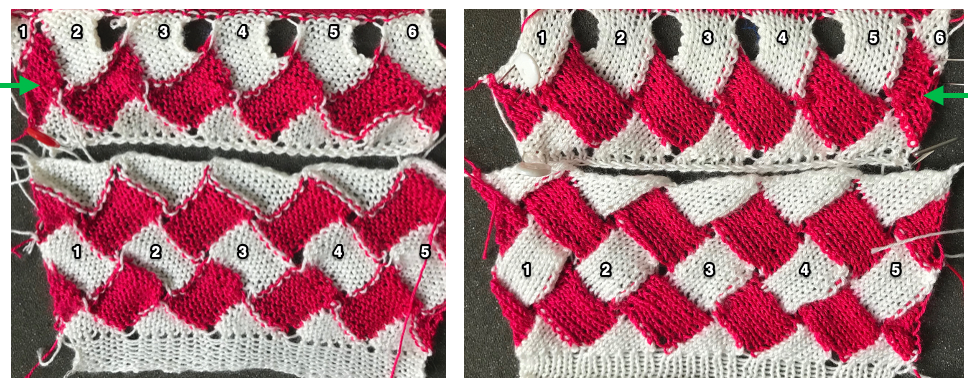 Lastly, a swatch ending in all knit rows. The only remaining issue is the fact that those side triangles are formed by stitches that are looser than across the rest of the piece. This yarn is thin and a poor choice, but fine for getting the technique down and beginning to understand what happens to stitches, how one needs to move from one side to the other, and what happens along the edges of each individual shape
Lastly, a swatch ending in all knit rows. The only remaining issue is the fact that those side triangles are formed by stitches that are looser than across the rest of the piece. This yarn is thin and a poor choice, but fine for getting the technique down and beginning to understand what happens to stitches, how one needs to move from one side to the other, and what happens along the edges of each individual shape 


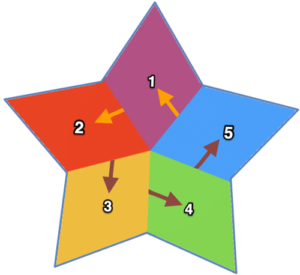 to consider the number of stitches required and whether the fact that other than garter stitch knit stitches are not square,
to consider the number of stitches required and whether the fact that other than garter stitch knit stitches are not square,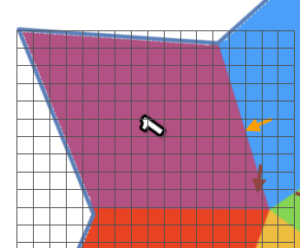
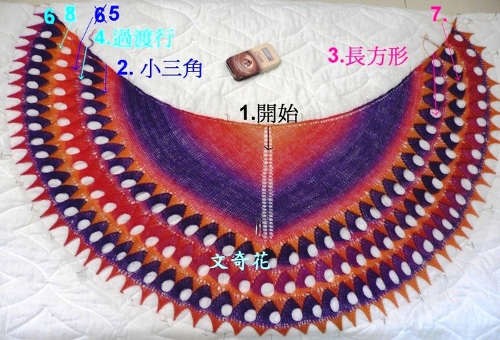
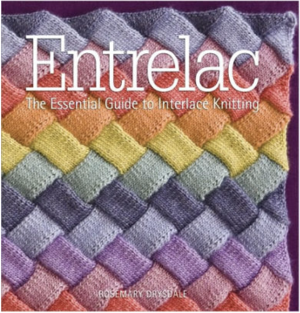







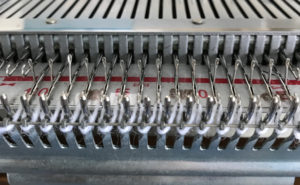
 Weaving cast-on only works on machines with weaving brushes ie Brother. I tend to knit with weaving brushes down no matter what the fabric is unless using them results in problems ie the particular yarn being used has a tendency to get caught up in them.
Weaving cast-on only works on machines with weaving brushes ie Brother. I tend to knit with weaving brushes down no matter what the fabric is unless using them results in problems ie the particular yarn being used has a tendency to get caught up in them. 
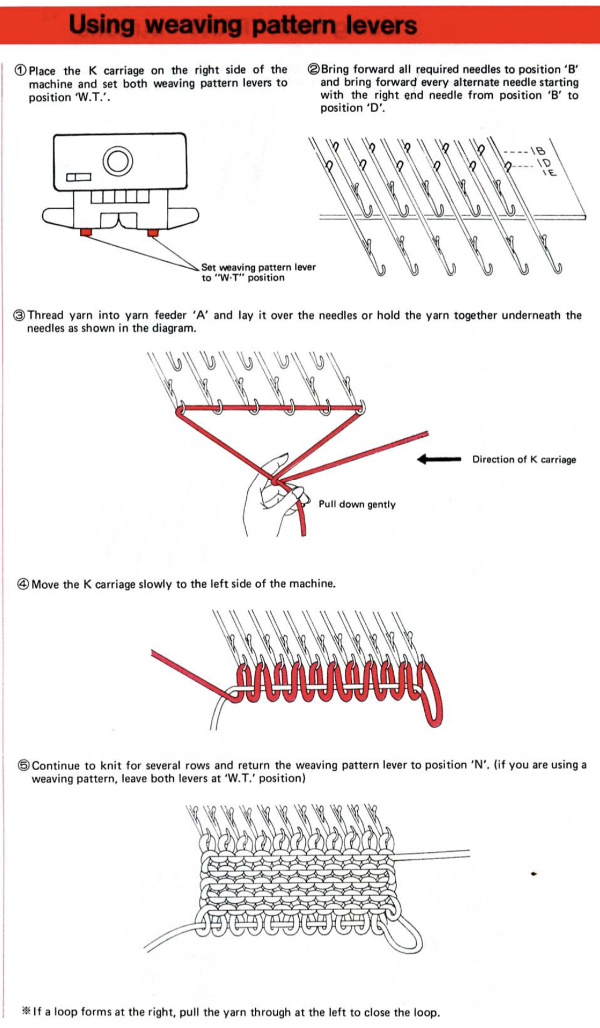


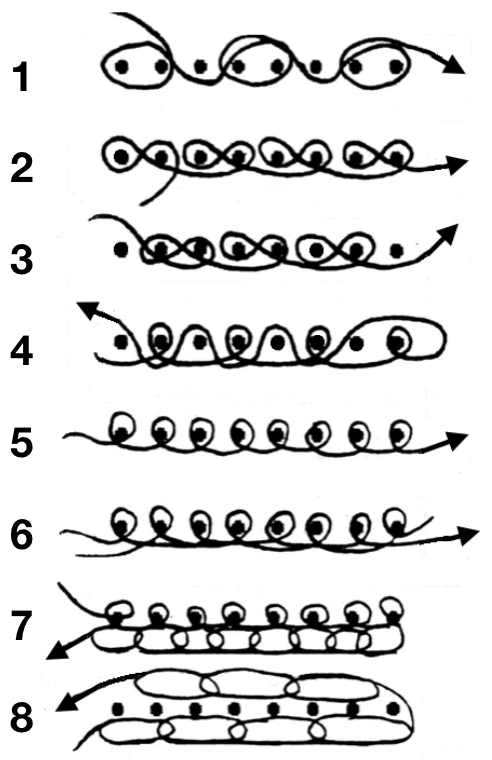
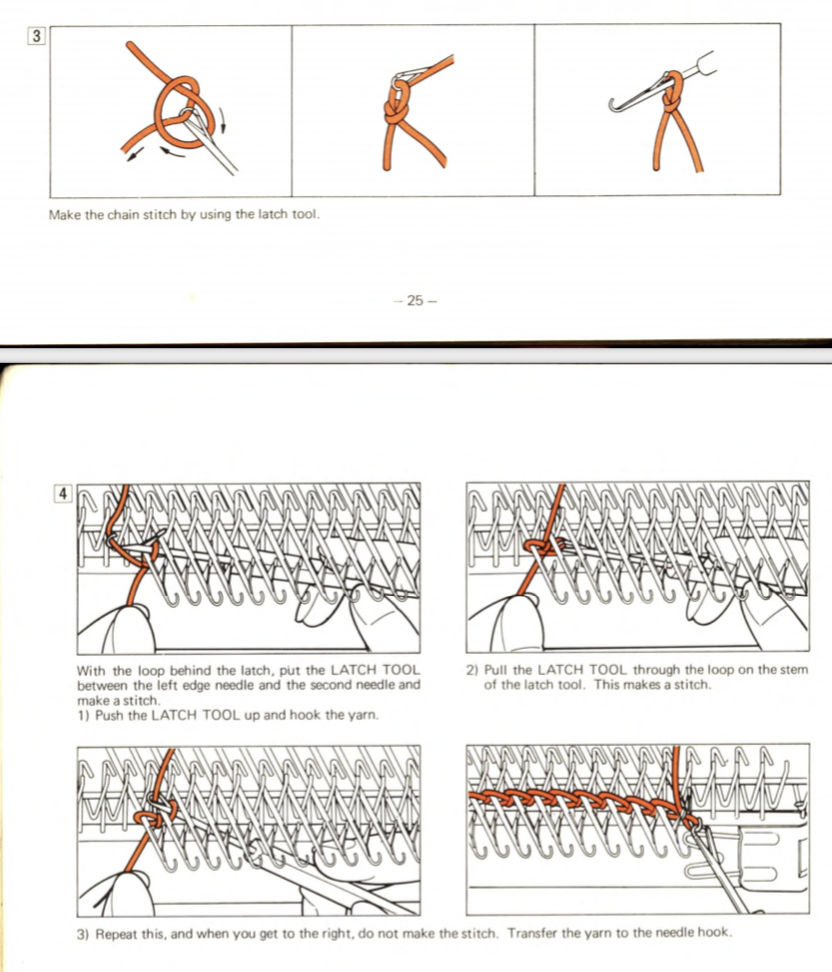

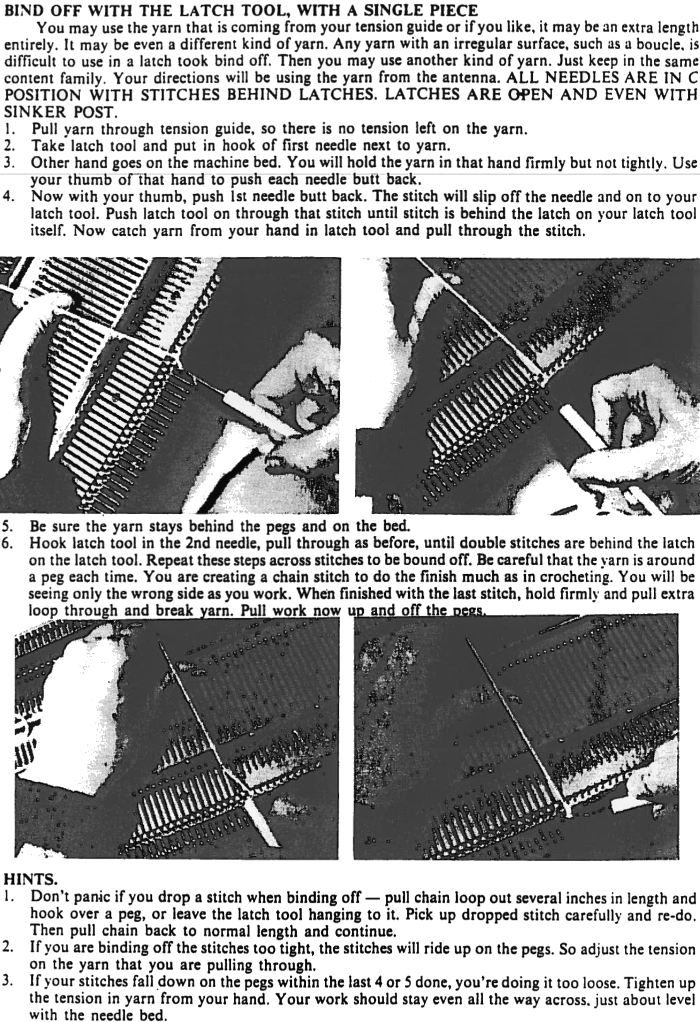
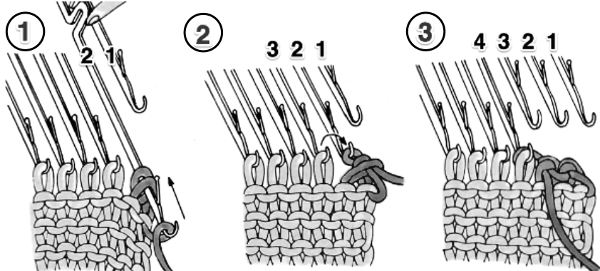

 A crochet hook could be used in place of the latch tool.
A crochet hook could be used in place of the latch tool.





 For mock rib executed on the single bed, for double rib as well, see
For mock rib executed on the single bed, for double rib as well, see 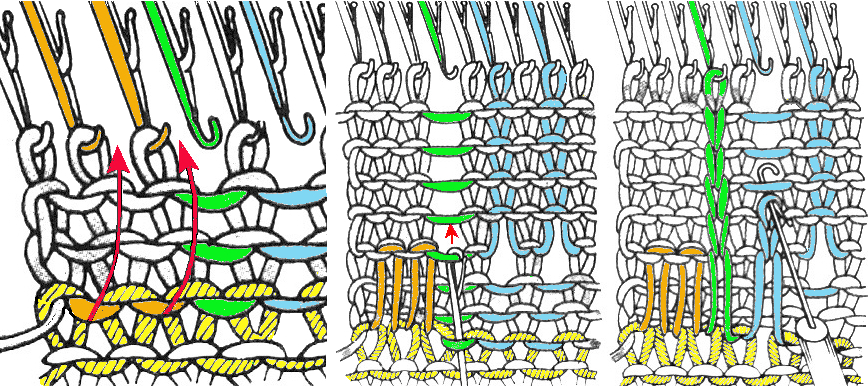
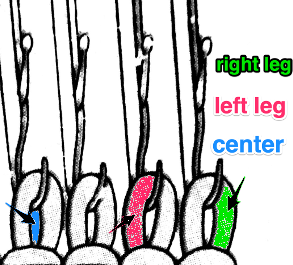
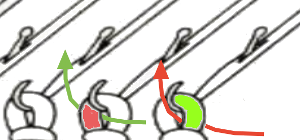 Reviewing approaches to binding off with needle and yarn: working single bed is sometimes performed on the machine and is illustrated below working from left to right. It is referred to as back or stem stitch and “sew off” method, and is shared in many of the old machine knitting manuals. It is easier to achieve if after knitting the last row one knits at least 2 or 3 more rows in waste yarn to make the stitches more accessible. The knit side shows single loops in view upon completion. Dropping small groups of stitches off as one makes progress across the row may make the technique easier, helping with the placement of the other hand to hold the work. On the machine, the fixed distances between needles and gate pegs help to keep the tension even. The backstitching may be done off the machine, but maintaining even tension there may be a bit harder.
Reviewing approaches to binding off with needle and yarn: working single bed is sometimes performed on the machine and is illustrated below working from left to right. It is referred to as back or stem stitch and “sew off” method, and is shared in many of the old machine knitting manuals. It is easier to achieve if after knitting the last row one knits at least 2 or 3 more rows in waste yarn to make the stitches more accessible. The knit side shows single loops in view upon completion. Dropping small groups of stitches off as one makes progress across the row may make the technique easier, helping with the placement of the other hand to hold the work. On the machine, the fixed distances between needles and gate pegs help to keep the tension even. The backstitching may be done off the machine, but maintaining even tension there may be a bit harder.


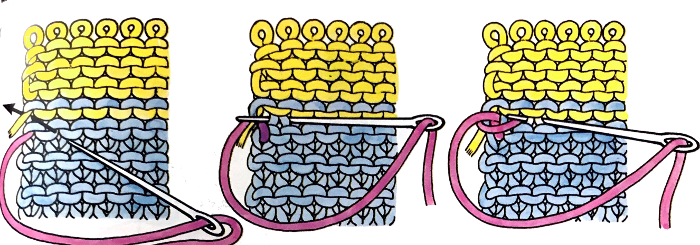
 or the needle and yarn sewing method may be used. There is a limit as to the length of yarn used so as not to pose problems. Very wide pieces may prove to be a challenge, requiring more than a single yarn end to complete the bind-off. My own yarn end max limit for sewing up or off is about 18 inches
or the needle and yarn sewing method may be used. There is a limit as to the length of yarn used so as not to pose problems. Very wide pieces may prove to be a challenge, requiring more than a single yarn end to complete the bind-off. My own yarn end max limit for sewing up or off is about 18 inches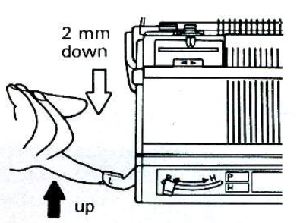





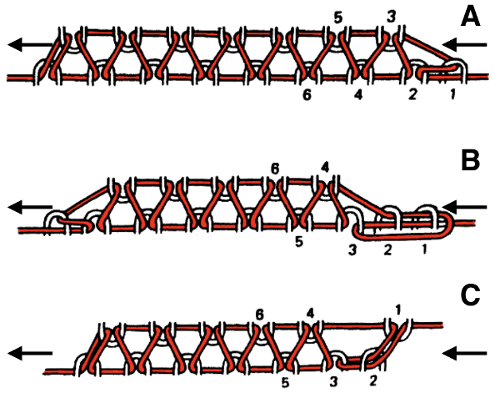
 I prefer an alternative method for waste yarn scrap off, ending in place of circular or U knitting: knit the last row in garment yarn. Thread up waste yarn, and knit it at single-bed tension. Knit 4 rows on one bed, with a separate strand or even a second contrasting color of equal weight, and knit 4 rows on the opposite bed. Repeat alternating until there are more than 12 rows on each bed and scrap off. This will allow you to press the waste knitting only, and the flaps are opened up to reveal the tops of the stitches created on each bed. Finishing can then be executed as below.
I prefer an alternative method for waste yarn scrap off, ending in place of circular or U knitting: knit the last row in garment yarn. Thread up waste yarn, and knit it at single-bed tension. Knit 4 rows on one bed, with a separate strand or even a second contrasting color of equal weight, and knit 4 rows on the opposite bed. Repeat alternating until there are more than 12 rows on each bed and scrap off. This will allow you to press the waste knitting only, and the flaps are opened up to reveal the tops of the stitches created on each bed. Finishing can then be executed as below.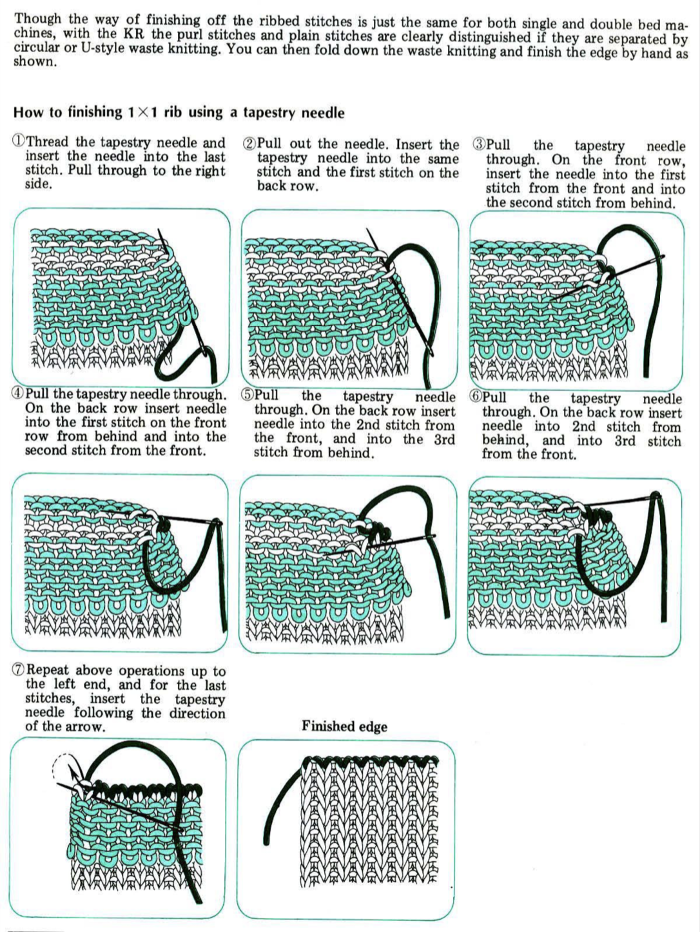
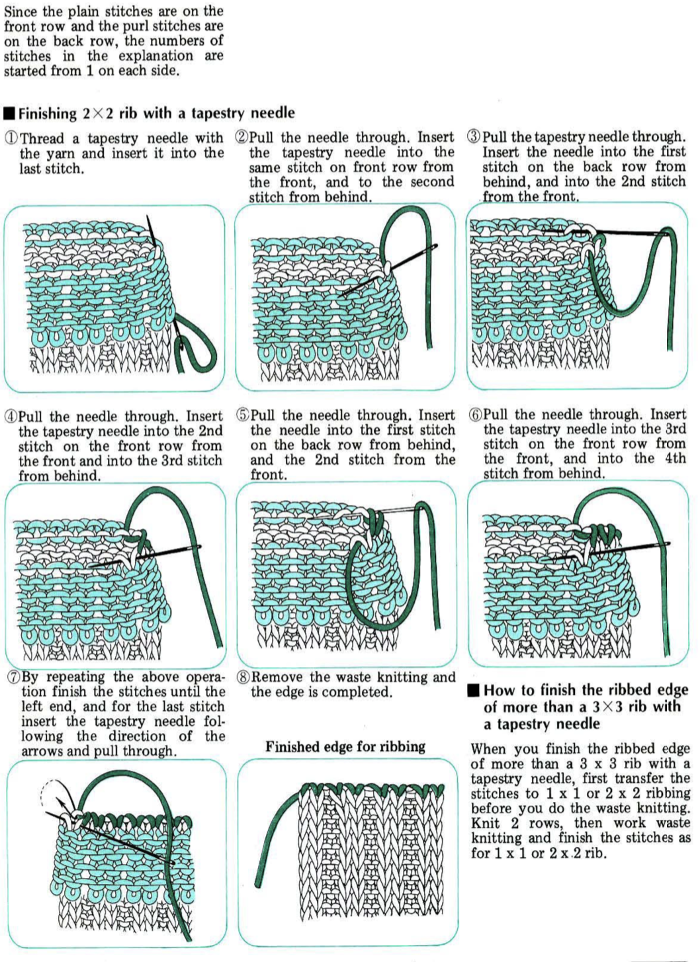

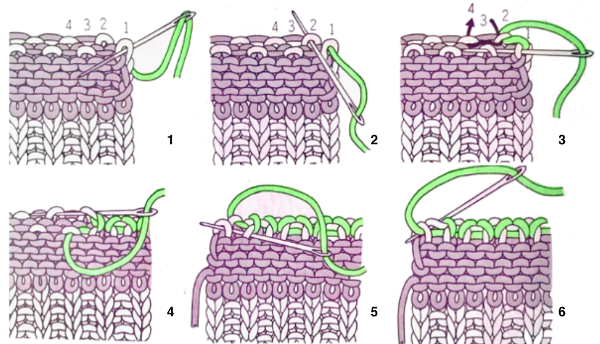



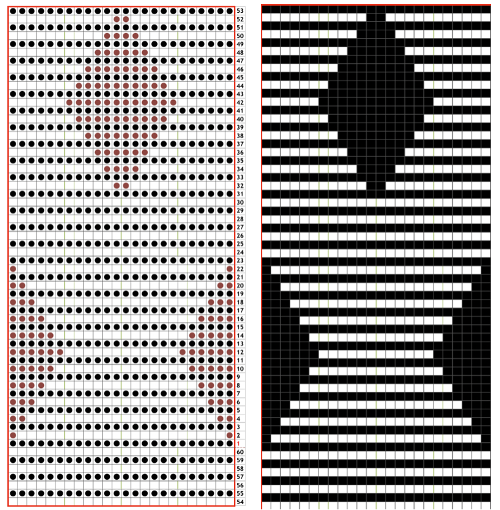
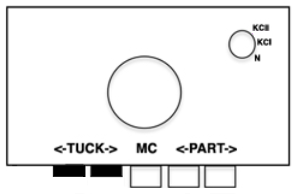

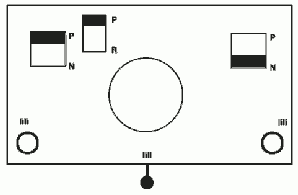


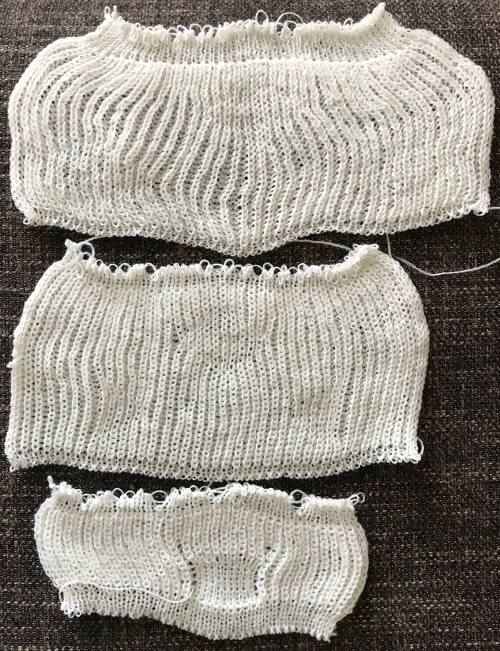

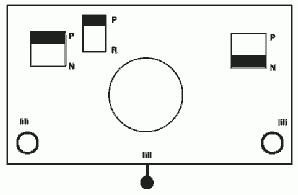


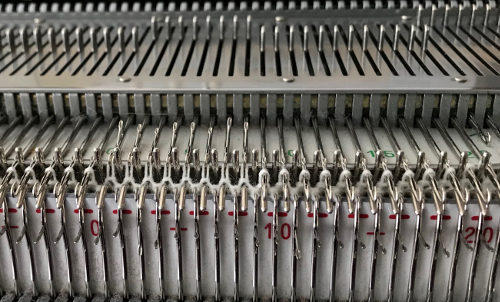
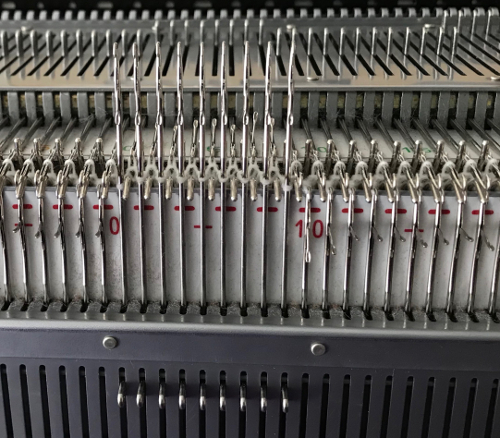

 Back to the original method used in the previous post where ribber settings are changed from knit to tuck <– –> every 2 rows along with color changes. I chose a design that would make it easy to identify the location of non-selected needles on the main bed in rows where the ribber will be set to tuck in both directions. The result is interesting, but the solid areas, narrower than the remaining knit, are in the opposite color to the dominant one on each side, the reverse of the inspiration fabric.
Back to the original method used in the previous post where ribber settings are changed from knit to tuck <– –> every 2 rows along with color changes. I chose a design that would make it easy to identify the location of non-selected needles on the main bed in rows where the ribber will be set to tuck in both directions. The result is interesting, but the solid areas, narrower than the remaining knit, are in the opposite color to the dominant one on each side, the reverse of the inspiration fabric.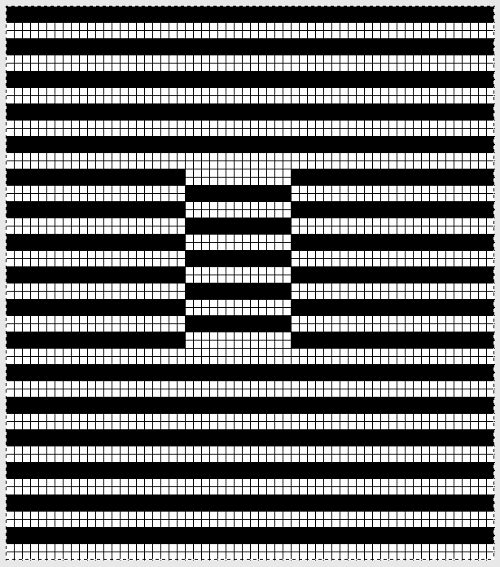
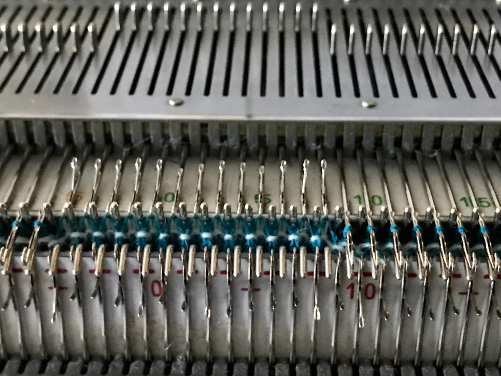

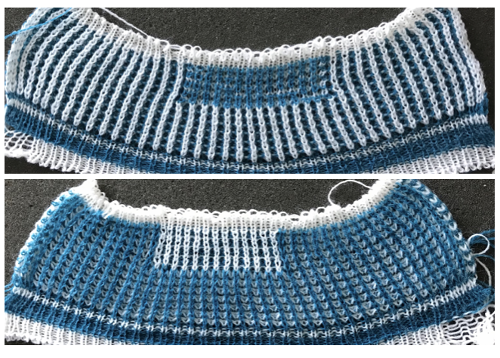

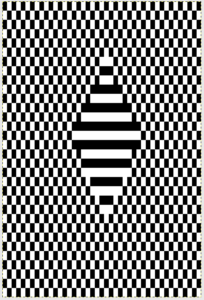



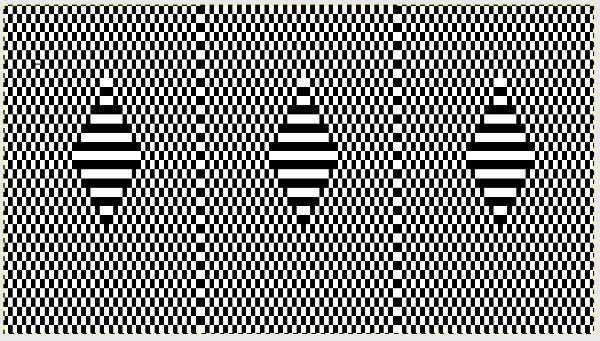
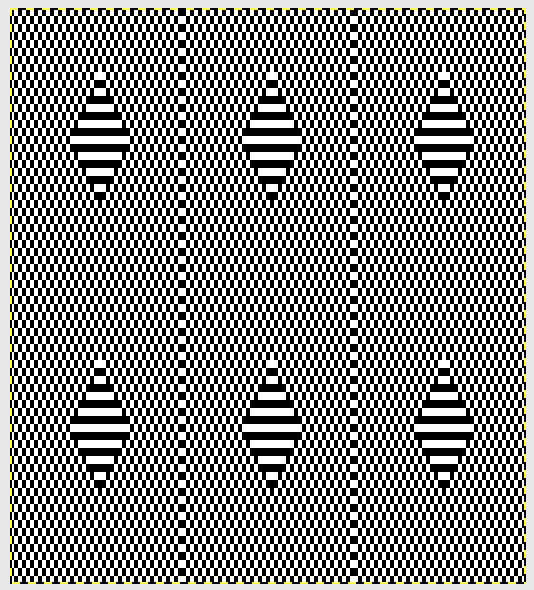

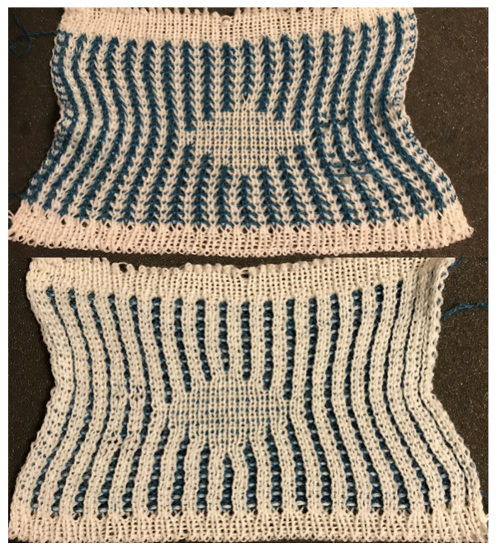



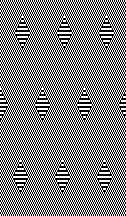
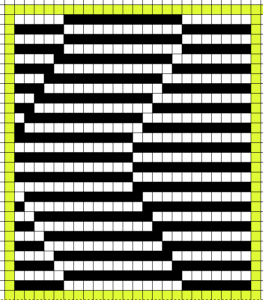



 The ribber remains set for knitting in both directions throughout, with the main bed set to tuck in both directions.
The ribber remains set for knitting in both directions throughout, with the main bed set to tuck in both directions.
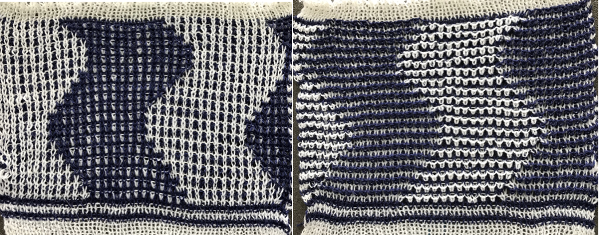

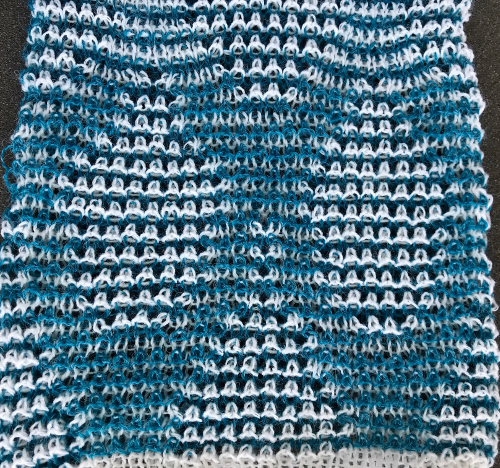

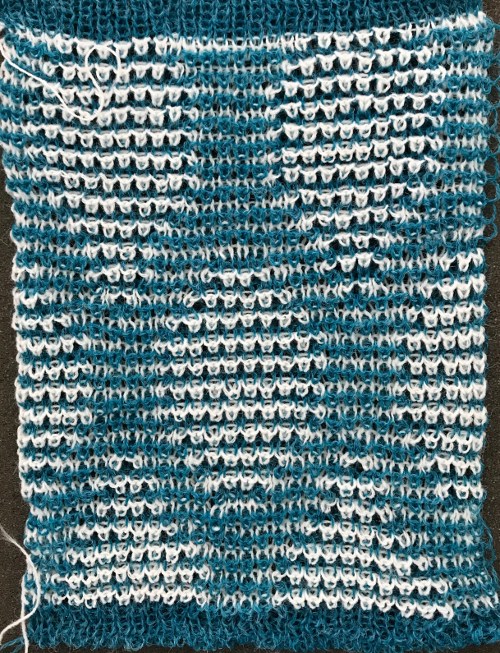

 The single 14X84 png
The single 14X84 png 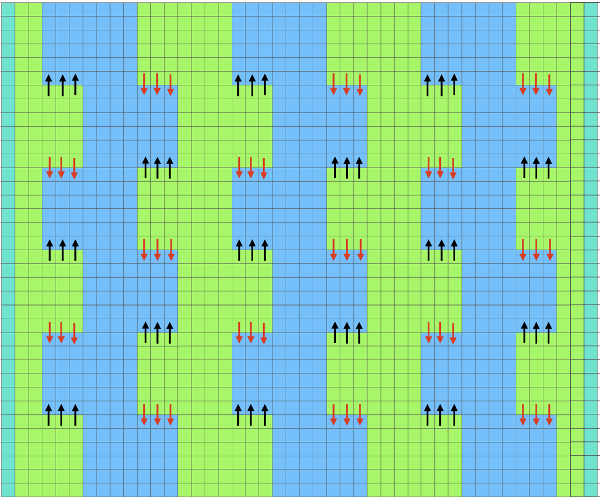










 and my small test swatch. The fold on each side and the swing in the pattern appear crisper and better defined to me
and my small test swatch. The fold on each side and the swing in the pattern appear crisper and better defined to me

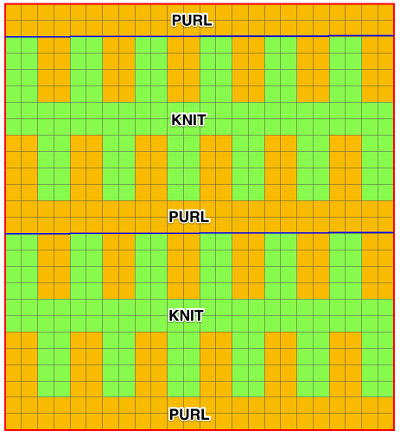
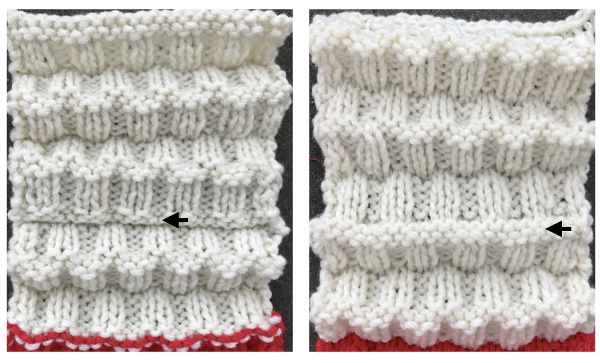 an attempt at a side view
an attempt at a side view  an earlier
an earlier 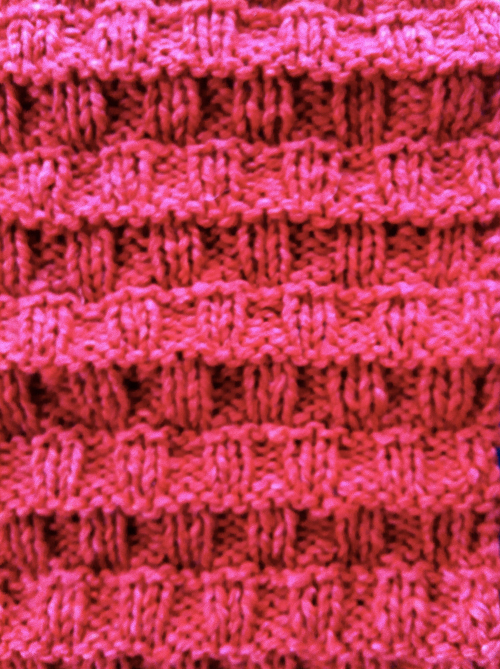 Another handknit swatch in worsted weight, perhaps suitable for G carriage
Another handknit swatch in worsted weight, perhaps suitable for G carriage 




